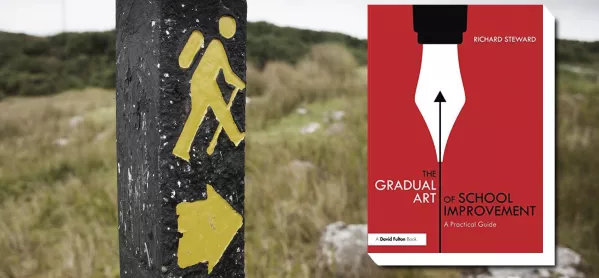- Home
- Book review: The Gradual Art of School Improvement
Book review: The Gradual Art of School Improvement

The Gradual Art of School Improvement: a practical guide
Author: Richard Steward
Publisher: Routledge
Details: 206pp, £19.99
ISBN 9780367136918
I am a fan of school leadership texts. I like nothing better than to be able to explore and reflect on the school development journeys of others, and am always hugely grateful to those who make the effort to share their experiences of walking these challenging paths.
I firmly believe that we have a professional duty to share our understanding and learn to be better at the work of teaching and learning, collectively and collegiately. Our combined experiences, from the perspective of all those involved in education (policymakers, researchers, leaders, teachers, pupils and the wider community), make for powerful learning.
As such, I am convinced that the Gradual Art of School Improvement offers some powerful learning for new-to-post and inexperienced secondary school leaders - in particular for those who are coming to the uncomfortable realisation that the work ahead of them is greater than they anticipated.
Slow-burn learning
The central tenet is that we should, as school leaders, fight against a culture of rapid and ultimately unsustainable school improvement. Instead, the author suggests, we should create a learning culture that focuses building the capacity and capability of others to learn in a slow-burn fashion.
In this sense, there is little to disagree with - who wouldn’t agree that schools should have an “intense and unremitting focus on teaching and learning,” or that “micromanagement is rarely effective”?
The book is intensely practical, with detailed guidance on a number of what the author considers to be key school-leadership challenges. Each one of the nine chapters outlines in an engaging style how the author established this slow-burn culture in his own school.
Advice presented ranges from how to plan an interview day for new senior leadership posts, to writing a headteacher report to governors, to how to set up line-management systems and departmental reviews. A wealth of appendices provides sample proformas, checklists and exemplars, which might be adapted and used in other contexts.
Unresolved tension
One chapter begins by stating that the myth of the hero head has been overturned - something worth celebrating. Another describes in detail the author’s viewpoint on the myth of governance, another about how he established an alternative school council to hear the opinions of “disaffected or disruptive pupils”.
Yet here lies an unresolved tension that sits at the heart of the book. Surely a headteacher who truly believes in distributed leadership regards the voices of all those in their team as an essential ingredient in the story? Are not the voices of the “disruptive pupils” worth hearing?
As I read, I found myself wanting to hear from the others who had been involved in the journey and used the strategies suggested. What did the pupils involved in the alternative school council really think? How did the teachers who participated in the teaching and learning reviews develop their practice? What does effective teaching and learning really look like?
In a recentTes article, Sir Kevan Collins, chief executive of the Education Endowment Foundation, suggested that if school leaders are not basing their decisions on research and evidence, they are using prejudice. The decision not to articulate the rich lattice of influences and evidence that has clearly helped to shape the decisions the author made in his headship limit the power and scope of the text. As such it becomes a rich, multi-layered case study of the school he has led.
Yet, in our increasingly evidence-informed times, relying purely on experience and opinion is a disadvantage. It meant that, for me, the text lacked a degree of power or depth. Unless you work in schools that are contextually and economically similar to examples used in the text (and I don’t), it is hard to draw any meaningful conclusions or to generalise further.
Operational practicalities
Overall, as it says, this is a book that focuses on the operational practicalities of school leadership in a secondary school. The anecdotal advice, proformas, tick lists and protocols will undoubtedly be helpful for inexperienced senior leaders and those looking to implement change rapidly.
As the long-standing headteacher of a successful school, the author shares his wisdom with clarity, authority and purpose, and we might be wise to consider them.
Megan Dixon is the co-director of the Aspirer Research School, and director of English for the Aspire Educational Trust. She is currently on secondment as a senior associate to the Education Endowment Foundation
You can support us by clicking the book’s title link: we may earn a commission from Amazon on any purchase you make, at no extra cost to you.
Keep reading for just £1 per month
You've reached your limit of free articles this month. Subscribe for £1 per month for three months and get:
- Unlimited access to all Tes magazine content
- Exclusive subscriber-only stories
- Award-winning email newsletters



